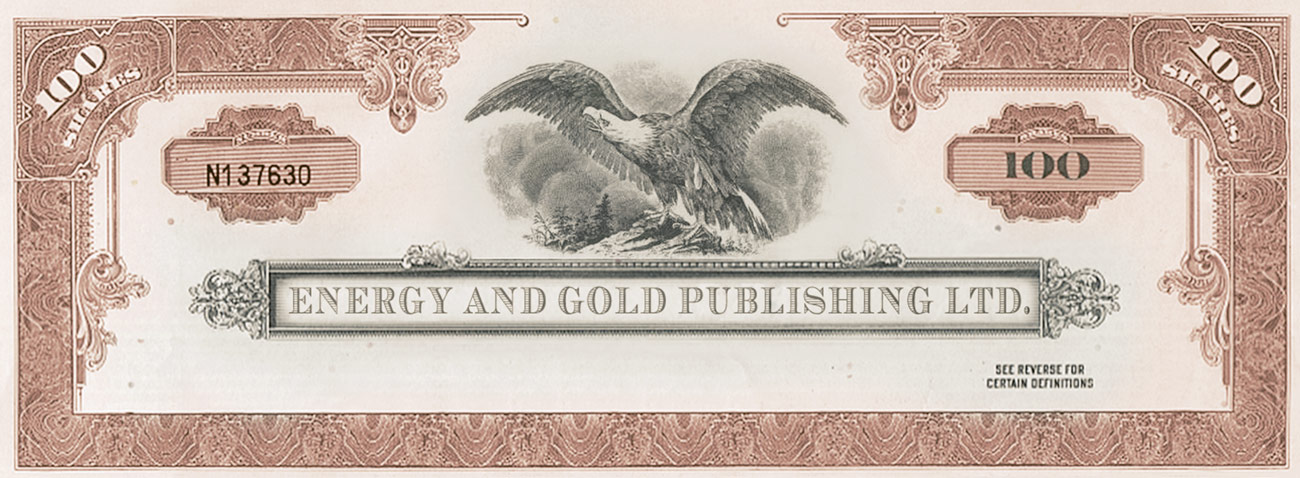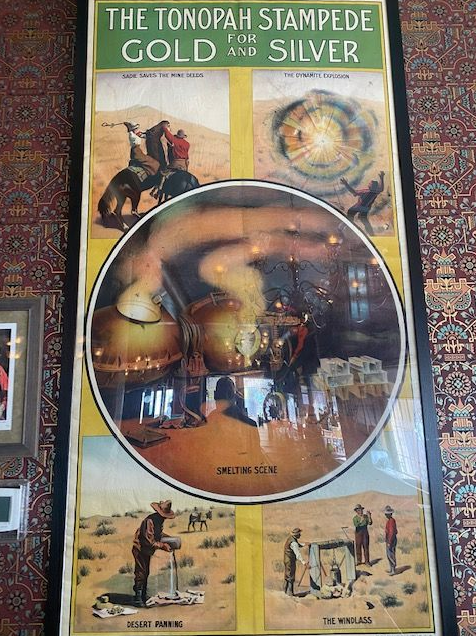People come to Las Vegas from all around the world in hopes of getting lucky and making a fortune. The allure of winning big is the foundation glitzy Las Vegas was built upon. For years, the gleaming city surrounded by desert has been an oasis for the risk-takers. But it wasn’t Nevada’s first. In fact, tourism and gambling are not even the biggest industries in the state. Long before slot machines and showgirls, people flocked to Nevada for a different kind of jackpot.
In the 1860s, the discovery of what is now known as the Comstock Lode caused a rush of small-time prospectors to descend upon Nevada. Comstock proved to be the richest silver discovery in the history of the United States. Multiple bonanza discoveries beginning in 1859 created a great deal of wealth for dozens of prospectors and helped the founding of the state of Nevada in 1864. As Comstock began fizzling out around the turn of the 20th century, another bonanza scale silver discovery was made in Tonopah, Nevada when a donkey kicked the dirt and revealed the treasure that lay beneath the surface.
On a chilly Nevada night in May 1900, Jim Butler’s mule wandered away from him. When he found the mule, he noticed outcropping rocks that appeared to be heavily laced with silver. Butler was at a desolate place called Tonopah Springs, Nevada.
Butler believed he had discovered an important silver deposit and took a number of samples. The assayer in nearby Klondike, Nevada disagreed and told him the samples were worthless, consisting mainly of iron, and he threw them into the back of his tent.
This is when Butler’s conviction that his find was genuine changed history. On his way back to his ranch, he stopped by Tonopah Springs to gather more samples. Back at his ranch, Butler put the samples on his windowsill. Soon thereafter, Tasker Oddie (soon to be governor of Nevada) stopped at the ranch and spotted the ore samples. He offered to pay for another assay, to which Butler agreed. Butler, in turn, offered Oddie a quarter interest in the assay. Oddie agreed and he took the ore samples to Austin assayer William Gayhart, offering Gayhart a quarter interest in his quarter. Gayhart found the assay ran as high as $600 a ton.
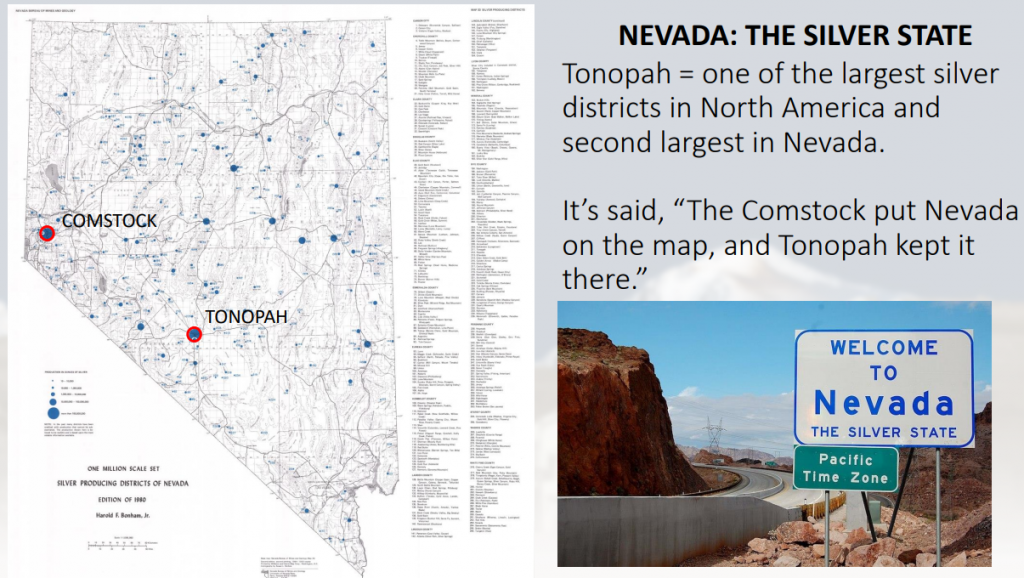
Remember, this was when silver was $1 per ounce, so $600 a ton meant the samples graded as high as 600 ounces per ton. These grades are absolutely unheard of in the modern mining environment in which 600 grams/ton is considered to be high-grade silver ore.
Butler would eventually file on eight claims near Tonopah Springs. Six of these – Desert Queen, Burro, Valley View, Silver Top, Buckboard, and Mizpah – turned into some of the biggest producers the state of Nevada has ever had.
The town of Tonopah quickly sprang up, and in 1902, the Tonopah-Belmont Mining Company was formed. The town of Tonopah eventually grew to a population of 10,000, and mine production from the district totaled more than US$120 million worth of gold, silver, copper, and lead between 1900 and 1921. After 1923, mining activity in Tonopah dried up, and the Great Depression of the 1930s followed by World War Two essentially ended all mining activity in Tonopah.
Then, in 1968, Howard Hughes and his Summa Corporation bought 100 claims in Tonopah including the Mizpah, Silver Top, and Desert Queen mines. Hughes held these claims throughout the 1970s, but he never did anything with them. Limited drilling on the Hughes claims was carried out by Echo Bay in the late 1980s, but low gold and silver prices in the early 1990s halted any activity by Echo Bay in the Tonopah District.
Today, Tonopah is experiencing a mining renaissance thanks to the efforts of two junior mining companies led by millennial CEOs. Due to the fact that Nevada is the most prolific mining state in the United States with some of the largest precious metals mines in the world, many mining analysts and market observers have operated under the notion that there isn’t much that is left to be discovered in Nevada. This notion is being put to rest by two gold/silver junior explorers that are committed to creating a mining renaissance in a mining district that has been dormant for more than 80 years.
In the last few years, new sets of eyes have begun to see potential where others had given up. What was previously understood to be the Tonopah Mining District has been reinvented through new sets of eyes and modern exploration techniques. The historical mining areas in and around Tonopah still hold considerable precious metals mineralization in the ground. However, it is the stepping out to the west, east and north that has really made Tonopah an intriguing junior mining exploration story.
I first visited Tonopah in August 2020 when both Blackrock and Summa had just begun their first drill programs at their respective projects in Tonopah. A lot has happened since, and this morning, Blackrock released its maiden resource estimate for its Tonopah West Project.
Of all the places I have traveled to in order to see mining projects, Tonopah is probably the most intriguing one. Geographically, the town has a little bit of everything. On one hand, Tonopah is only a three hour drive from Las Vegas and straddles a major road (state road 95). On the other hand, Tonopah is basically located in the middle of nowhere with stretches of empty land extending for miles in all directions.
When you walk around Tonopah, you feel its mining roots and the history of the town is evident everywhere you look. In fact, the Tonopah Mining Museum is one of the main attractions that the town offers to visitors. And the Mizpah Hotel, one of the original hotels that sprung up shortly after Jim Butler’s mule discovered bonanza-grade silver, has an entire room dedicated to Tonopah’s mining history and the gold and silver rush that started it all.
A poster from the turn of the 20th century hanging in the Mizpah Hotel
While walking down the main street in Tonopah on a Friday afternoon, a lady walking in the other direction encouraged me to “spend money in town, we need it.” Blackrock Silver (TSX-V:BRC, OTC: BKRRF) and Summa Silver (TSX-V:SSVR, OTC:SSVRF) have been doing their part to spend money in Tonopah including hosting multiple site visits for analysts and investors in recent months. In addition, Blackrock and Summa have sponsored the Tonopah Rodeo, local youth sports teams, and regularly support Tonopah hotels and restaurants.
Blackrock and Summa have already delivered a significant stimulus to the town’s economy while carrying out significant exploration programs in the last two years. Perhaps most importantly, by employing several geologists that live in Tonopah at least part time. The resurgence of mineral exploration has been a huge benefit to the economy of this town of 2,000 people.
It was clear to me from the locals I saw and spoke to that this is a pro-mining town. As long as mining firms are responsible neighbors that care about the environment and the local population, I believe the people of Tonopah will continue to be supportive of this nascent Tonopah mining renaissance.
Turning to the actual exploration work and drilling that these two companies have conducted since 2020, it is becoming increasingly clear that Tonopah has strong potential to host upwards of 100,000,000 silver-equivalent ounces. Since summer 2020, Blackrock Silver has managed to greatly expand six different vein zones at Tonopah West, including the impressively high-grade Victor and Paymaster Veins. The Victor Vein was the one that delivered the bonanza-grade intercepts in July 2020 that sent BRC shares skyrocketing over $1.00 for the first time.
BRC.V (February 2020 to September 2020)
On BRC’s side of the district it is called the Victor Vein, and on Summa’s side the same vein is called the Murray Vein. Summa has had some impressive intercepts at Murray (including intercepts grading more than 4,000 g/t Ag-Eq), and the company currently has two drill rigs working to infill and expand the Murray Vein Zone.
Based upon drilling in the areas in and around historic mining, I believe I can safely conclude that Tonopah hosts somewhere in the neighborhood of one hundred million silver-equivalent ounces. However, it is the stepping out in all directions that opens up the possibility that Tonopah could enter a renaissance of mining activity. Summa intersected quartz veining with gold/silver mineralization in two diamond drill holes at its Ruby Target, 1,300 meters to the southeast of the Belmont Mine Area. Blackrock followed that up by drilling a 1,000 meter step-out to the northwest of areas of known mineralization at Tonopah West, BRC managed to intersect a 4.5 meter interval of quartz vein material with this step-out. BRC believes that the vein it intersected to the northwest is the Denver Vein. Drilling is currently underway to trace the edges of the caldera that surrounds Tonopah.
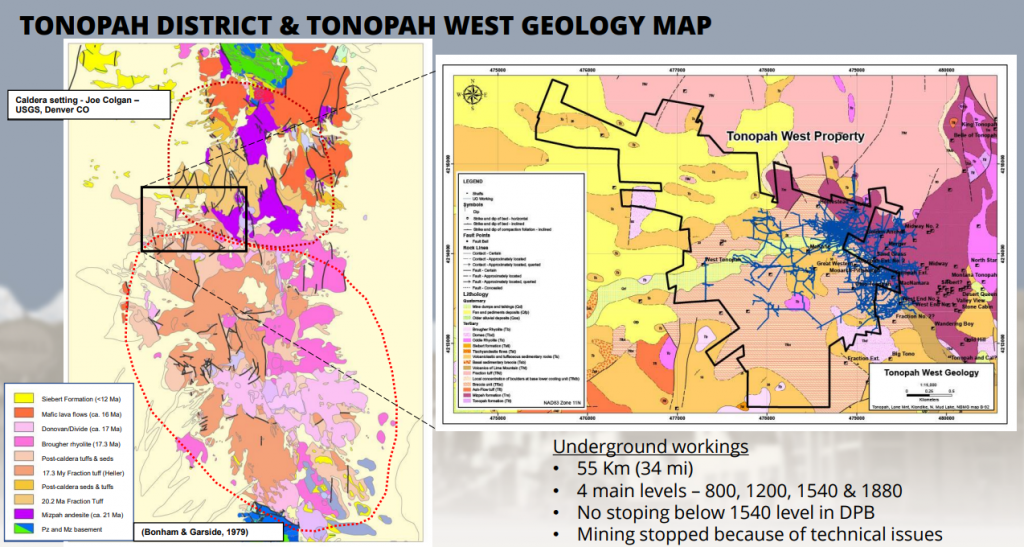
Looking at Blackrock’s drill plan map showing the six different vein zones, it’s clear just how much room is left for existing vein zones to be extended and new vein zones to be discovered:
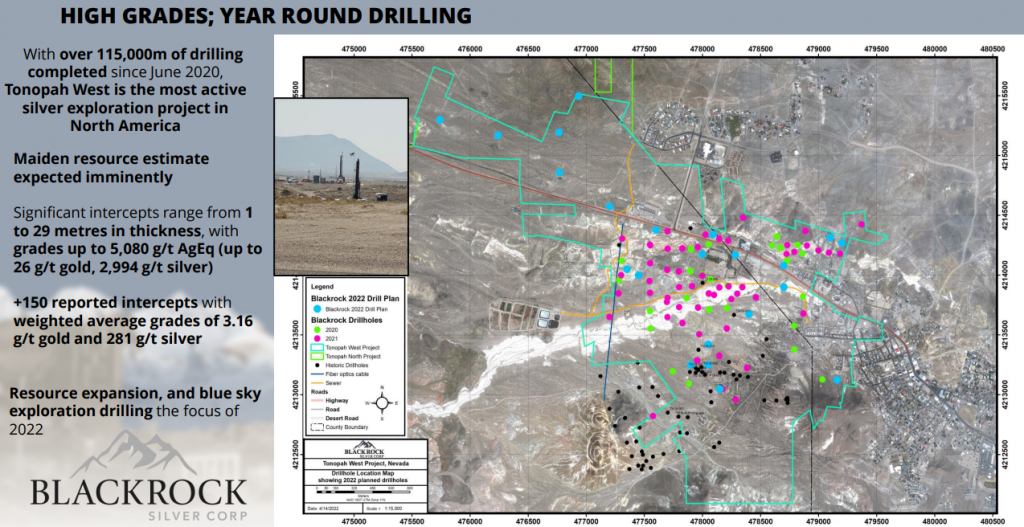
To date, Blackrock has reported more than 150 drill intercepts at Tonopah West. And the weighted average grades of these intercepts is 3.16 g/t gold and 281 g/t silver – One consistent theme in historic mining areas of Nevada is how rare it was for the old timers to mine deeper than 100 feet, and below 1000 feet was absolutely out of the question. This leaves a lot of gold and silver left behind at depth simply because they did not have the technology required to drill/mine at such depths.
Blackrock produced a maiden resource estimate for Tonopah West totaling 42,614,000 silver-equivalent ounces at a diluted grade of 446 g/t silver-equivalent. Blackrock used conversative metals prices (US$1750 for gold and US$20.00 for silver) and the average grade is still more than 2x the cut-off grade of 200 g/t Ag-Eq. This initial resource estimate for Tonopah West makes it the 2nd highest grade gold/silver deposit above 40 million Ag-Eq ounces on the planet (Silvercrest’s Las Chispas is #1).
The results to date at Tonopah West demonstrate several key aspects of the project:
- Its high-grade nature and the significant potential for further resource expansion through definition drilling of high-grade gold/silver shoots.
- How little the old timers understood the geology at Tonopah and how much gold and silver was left in the earth, both at depth and along strike in all directions.
- Potential for resource expansion at depth (Blackrock hasn’t found the bottom of the gold/silver mineralized zones).
- BRC’s Tonopah West Project remains open to the North, North-West, with step-out drilling already having confirmed mineralization significantly beyond the DPB resource area.

Summa has expanded its claims package on the east side of the Tonopah Mining District by staking an additional 1,446 acres of mineral rights contiguous with the Hughes Property:
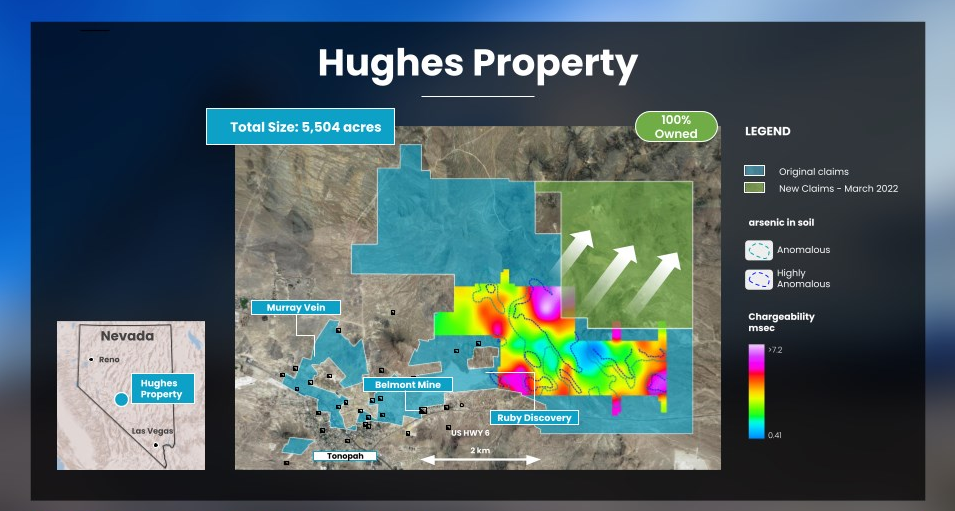
The newly staked claims are centered approximately 4.6 kilometers northeast of the Belmont Mine and 3 kilometers northeast of the Ruby Discovery. The claims remain largely unexplored due to the presence of post-mineralization cover rocks. Furthermore, previously reported geophysical and soil geochemical data highlighted numerous untested targets interpreted to have potential for high-grade silver-gold veins. And many of these targets remain open for expansion towards and into the newly acquired claims.
Summa VP of exploration Chris York showed me around some of Summa’s new claims including an impressive breccia outcrop that’s roughly 2,000 meters northeast of Summa’s biggest step-out hole to date.
The breccia outcrop is really intriguing because it represents a location where hot fluids from the hydrothermal system vented near the surface. The outcrop consists of calcite, low temperature quartz, and brecciated/fragmented rock clasts of the formation below. The low temperature quartz suggests that what Summa has found at surface is higher in the hydrothermal system and the system will need to be drilled at deeper depths.
Field mapping along with a geophysical Induced Polarity (IP) and resistivity survey also validate the structures in the area. Furthermore, soil sampling in the area yielded anomalous geochemistry in the area around the breccia outcrop. Finally, host rocks in the area have historically been favorable to mineralization. Having all of these different data sets corroborate a similar story increases Summa’s confidence in prospectivity of the area.
Summa’s geologists interpret the breccia outcrop to be part of an epithermal system. These types of epithermal systems follow a fairly well behaved model where elevation in the system is very important. For these types of deposits the ‘boiling zone’ is the key target area, and this zone typically occurs at depths greater than 300 meters below the top of the system. This zone is where the majority of any precious metals in the system are deposited.
While two diamond core drill rigs work to drill out a maiden resource estimate for the Murray Zone, Summa’s team of geos is conducting surface sampling and mapping across the rest of the project area. The goal will be to move the drill rigs out to some of these step-out targets across the project area later in the year once the Murray Zone has been thoroughly drilled out.
Drilling out a maiden resource at Hughes is Summa’s main focus for the next couple months. However, the company’s other project, Mogollon in New Mexico, is a huge part of the Summa Silver story. Summa completed six drill holes at Mogollon, and there is ample reason for excitement based upon initial results (intersections of 11.6 meters grading 450 g/t silver-eq and 13.6 meters of 220 g/t silver-equivalent in the first few holes that Summa has drilled at Mogollon) and visual analysis of the drill core.
Summa is committed to advancing both Hughes and Mogollon to maiden resource estimates this year. Based upon what we’ve seen so far at each project, it is probable that Summa will be able to produce combined resources of between 50,000,000 and 70,000,000 silver-equivalent ounces at both projects. This is a pretty good starting point when one considers that Summa has only drilled a small portion of its property package in Tonopah, and only one vein zone out of more than a dozen target areas at Mogollon:
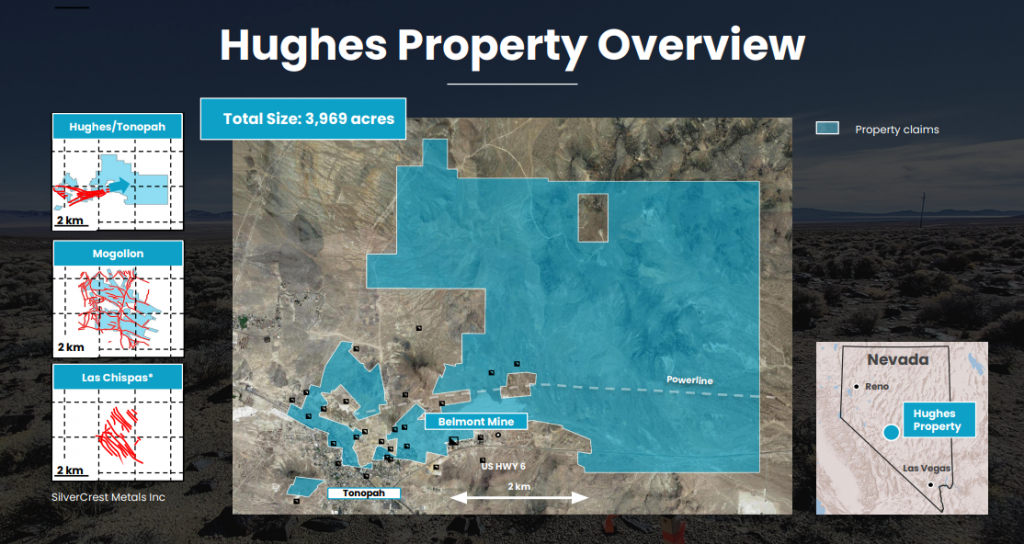
While the drill intersections and the scale of the gold and silver resources at Tonopah are certainly impressive, the CEOs of both companies are an integral part of the story. Blackrock is led by CEO Andrew Pollard, a 37 year old first time junior mining CEO who has brought Blackrock from a $1.2 million market cap in early 2019 to a $200 million market cap today. Pollard is a visionary leader who has a rare gift of being able to constantly think outside the box and inspire investors to see his increasingly large vision for what Blackrock will become. By teaming up with Blackrock Chairman Bill Howald, Pollard has been able to leverage his Vancouver capital markets expertise with Howald’s four decades of Nevada gold mining experience. A perfect duo committed to writing the next chapter in the Tonopah mining saga.
Summa Silver is led by Galen McNamara, a talented geologist who cut his junior mining teeth as one of the integral team members at NexGen Energy helping to discover one of the most valuable uranium deposits in history. McNamara loves geology and the thrill of discovery. When he talks about step-out holes at Ruby in Tonopah, or 50 meter vein intersections at Mogollon his excitement and passion for mineral exploration is palpable.
Both Pollard and McNamara are first time CEOs in their late-30s. However, it is no accident these men were selected to lead these two companies to where they are today: a combined C$300 million in market capitalization with multi-million dollar investments from billionaire mining investor Eric Sprott, and NYSE listed gold/silver producer First Majestic Silver. Tonopah is one of the best stories in the junior mining sector today, and both companies stand on the brink of reinventing one of the great American mining districts. I can’t help but root for Blackrock and Summa to have enormous success and generate wealth for all stakeholders, especially the small town folks of Tonopah, Nevada.
UPDATE: This morning’s precious metals dump in combination with the tendency to ‘sell on the news’ in junior mining has delivered an opportunity to buy BRC.V shares below $1.00 and I intend to add to my position on this weakness.
Disclosure: Author owns shares of BRC.V and SSVR.V at the time of publishing and may choose to buy or sell at any time without notice.
________________________________________________________________________________________
Disclaimer:
The article is for informational purposes only and is neither a solicitation for the purchase of securities nor an offer of securities. Readers of the article are expressly cautioned to seek the advice of a registered investment advisor and other professional advisors, as applicable, regarding the appropriateness of investing in any securities or any investment strategies, including those discussed above. Summa Silver Corp. is a high-risk venture stock and not suitable for most investors. Consult Summa SIlver Corp’s SEDAR profiles for important risk disclosures. EnergyandGold has been compensated for marketing & promotional services by Summa Silver Corp. so some of EnergyandGold.com’s coverage could be biased. EnergyandGold.com, EnergyandGold Publishing LTD, its writers and principals are not registered investment advisors and advice you to do your own due diligence with a licensed investment advisor prior to making any investment decisions.
This article contains certain forward-looking information and forward-looking statements within the meaning of applicable securities legislation (collectively “forward-looking statements”). Certain information contained herein constitutes “forward-looking information” under Canadian securities legislation. Generally, forward-looking information can be identified by the use of forward-looking terminology such as “expects”, “believes”, “aims to”, “plans to” or “intends to” or variations of such words and phrases or statements that certain actions, events or results “will” occur. Forward-looking statements are based on the opinions and estimates of management as of the date such statements are made and they are subject to known and unknown risks, uncertainties and other factors that may cause the actual results, level of activity, performance or achievements of the Company to be materially different from those expressed by such forward-looking statements or forward-looking information, standard transaction risks; impact of the transaction on the parties; and risks relating to financings; regulatory approvals; foreign country operations and volatile share prices. Although management of the Company has attempted to identify important factors that could cause actual results to differ materially from those contained in forward-looking statements or forward-looking information, there may be other factors that cause results not to be as anticipated, estimated or intended. There can be no assurance that such statements will prove to be accurate, as actual results and future events could differ materially from those anticipated in such statements. Actual results may differ materially from those currently anticipated in such statements. The views expressed in this publication and on the EnergyandGold website do not necessarily reflect the views of Energy and Gold Publishing LTD, publisher of EnergyandGold.com. Accordingly, readers should not place undue reliance on forward-looking statements and forward looking information. The Company does not undertake to update any forward-looking statements or forward-looking information that are incorporated by reference herein, except as required by applicable securities laws. Always thoroughly do your own due diligence and talk to a licensed investment adviser prior to making any investment decisions. Junior resource companies can easily lose 100% of their value so read company profiles on www.SEDAR.com for important risk disclosures. It’s your money and your responsibility.
